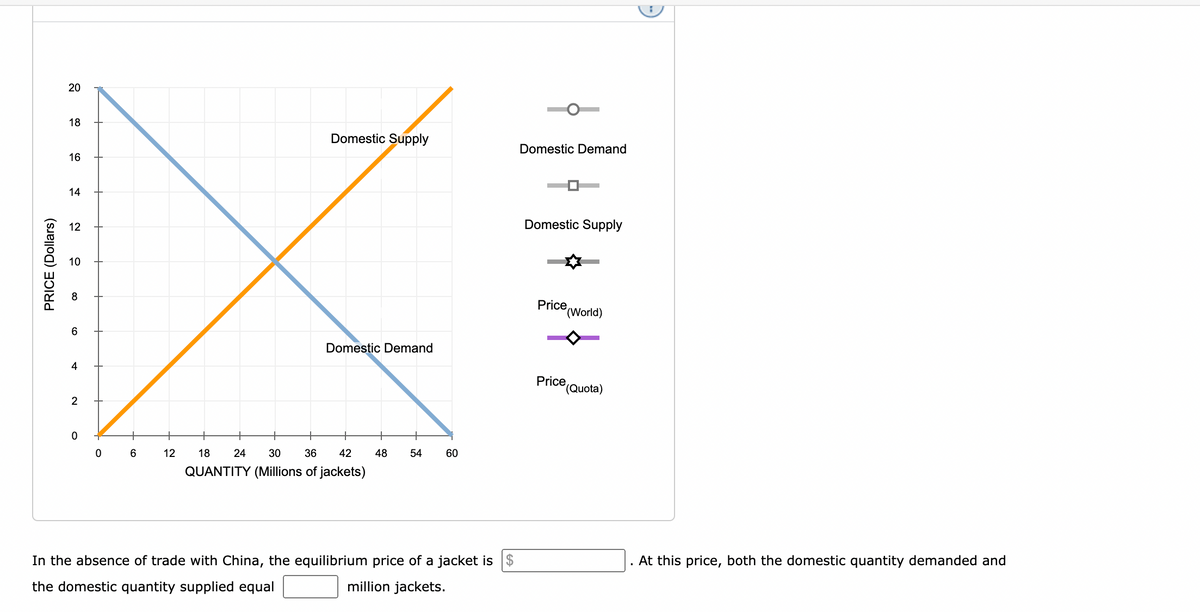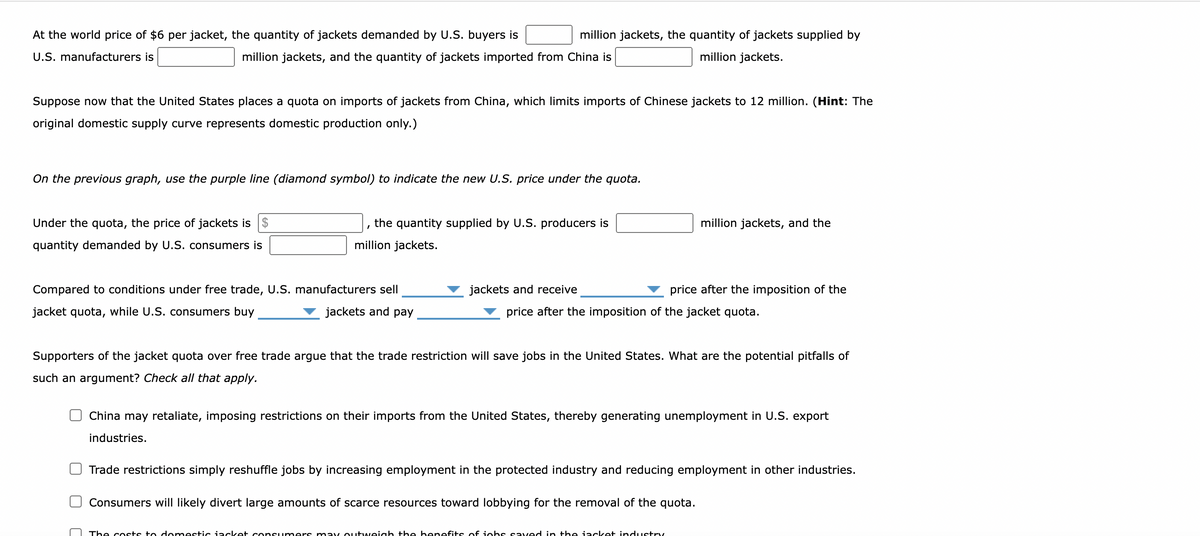20 20 18 Domestic Supply Domestic Demand 16 PRICE (Dollars) 14 12 10 10 2 Domestic Supply Price (World) Domestic Demand Price (Quota) 0 06 12 18 24 30 36 42 48 54 60 QUANTITY (Millions of jackets) In the absence of trade with China, the equilibrium price of a jacket is $ the domestic quantity supplied equal million jackets. At this price, both the domestic quantity demanded and At the world price of $6 per jacket, the quantity of jackets demanded by U.S. buyers is U.S. manufacturers is million jackets, the quantity of jackets supplied by million jackets, and the quantity of jackets imported from China is million jackets. Suppose now that the United States places a quota on imports of jackets from China, which limits imports of Chinese jackets to 12 million. (Hint: The original domestic supply curve represents domestic production only.) On the previous graph, use the purple line (diamond symbol) to indicate the new U.S. price under the quota. Under the quota, the price of jackets is $ quantity demanded by U.S. consumers is 1 the quantity supplied by U.S. producers is million jackets. million jackets, and the jackets and receive jackets and pay price after the imposition of the price after the imposition of the jacket quota. Compared to conditions under free trade, U.S. manufacturers sell jacket quota, while U.S. consumers buy Supporters of the jacket quota over free trade argue that the trade restriction will save jobs in the United States. What are the potential pitfalls of such an argument? Check all that apply. China may retaliate, imposing restrictions on their imports from the United States, thereby generating unemployment in U.S. export industries. Trade restrictions simply reshuffle jobs by increasing employment in the protected industry and reducing employment in other industries. Consumers will likely divert large amounts of scarce resources toward lobbying for the removal of the quota. The costs to domestic jacket consumers may outweigh the benefits of jobs saved in the jacket industry
20 20 18 Domestic Supply Domestic Demand 16 PRICE (Dollars) 14 12 10 10 2 Domestic Supply Price (World) Domestic Demand Price (Quota) 0 06 12 18 24 30 36 42 48 54 60 QUANTITY (Millions of jackets) In the absence of trade with China, the equilibrium price of a jacket is $ the domestic quantity supplied equal million jackets. At this price, both the domestic quantity demanded and At the world price of $6 per jacket, the quantity of jackets demanded by U.S. buyers is U.S. manufacturers is million jackets, the quantity of jackets supplied by million jackets, and the quantity of jackets imported from China is million jackets. Suppose now that the United States places a quota on imports of jackets from China, which limits imports of Chinese jackets to 12 million. (Hint: The original domestic supply curve represents domestic production only.) On the previous graph, use the purple line (diamond symbol) to indicate the new U.S. price under the quota. Under the quota, the price of jackets is $ quantity demanded by U.S. consumers is 1 the quantity supplied by U.S. producers is million jackets. million jackets, and the jackets and receive jackets and pay price after the imposition of the price after the imposition of the jacket quota. Compared to conditions under free trade, U.S. manufacturers sell jacket quota, while U.S. consumers buy Supporters of the jacket quota over free trade argue that the trade restriction will save jobs in the United States. What are the potential pitfalls of such an argument? Check all that apply. China may retaliate, imposing restrictions on their imports from the United States, thereby generating unemployment in U.S. export industries. Trade restrictions simply reshuffle jobs by increasing employment in the protected industry and reducing employment in other industries. Consumers will likely divert large amounts of scarce resources toward lobbying for the removal of the quota. The costs to domestic jacket consumers may outweigh the benefits of jobs saved in the jacket industry
Chapter4: Demand, Supply, And Markets
Section: Chapter Questions
Problem 4.7P
Related questions
Question
View picture
Also On the graph, use the grey line (star symbol) to indicate the world price of jackets.

Transcribed Image Text:20
20
18
Domestic Supply
Domestic Demand
16
PRICE (Dollars)
14
12
10
10
2
Domestic Supply
Price (World)
Domestic Demand
Price
(Quota)
0
06
12
18
24
30
36
42
48
54
60
QUANTITY (Millions of jackets)
In the absence of trade with China, the equilibrium price of a jacket is $
the domestic quantity supplied equal
million jackets.
At this price, both the domestic quantity demanded and

Transcribed Image Text:At the world price of $6 per jacket, the quantity of jackets demanded by U.S. buyers is
U.S. manufacturers is
million jackets, the quantity of jackets supplied by
million jackets, and the quantity of jackets imported from China is
million jackets.
Suppose now that the United States places a quota on imports of jackets from China, which limits imports of Chinese jackets to 12 million. (Hint: The
original domestic supply curve represents domestic production only.)
On the previous graph, use the purple line (diamond symbol) to indicate the new U.S. price under the quota.
Under the quota, the price of jackets is $
quantity demanded by U.S. consumers is
1
the quantity supplied by U.S. producers is
million jackets.
million jackets, and the
jackets and receive
jackets and pay
price after the imposition of the
price after the imposition of the jacket quota.
Compared to conditions under free trade, U.S. manufacturers sell
jacket quota, while U.S. consumers buy
Supporters of the jacket quota over free trade argue that the trade restriction will save jobs in the United States. What are the potential pitfalls of
such an argument? Check all that apply.
China may retaliate, imposing restrictions on their imports from the United States, thereby generating unemployment in U.S. export
industries.
Trade restrictions simply reshuffle jobs by increasing employment in the protected industry and reducing employment in other industries.
Consumers will likely divert large amounts of scarce resources toward lobbying for the removal of the quota.
The costs to domestic jacket consumers may outweigh the benefits of jobs saved in the jacket industry
Expert Solution
This question has been solved!
Explore an expertly crafted, step-by-step solution for a thorough understanding of key concepts.
This is a popular solution!
Trending now
This is a popular solution!
Step by step
Solved in 2 steps with 1 images

Recommended textbooks for you


Principles of Macroeconomics (MindTap Course List)
Economics
ISBN:
9781305971509
Author:
N. Gregory Mankiw
Publisher:
Cengage Learning

Principles of Microeconomics
Economics
ISBN:
9781305156050
Author:
N. Gregory Mankiw
Publisher:
Cengage Learning


Principles of Macroeconomics (MindTap Course List)
Economics
ISBN:
9781305971509
Author:
N. Gregory Mankiw
Publisher:
Cengage Learning

Principles of Microeconomics
Economics
ISBN:
9781305156050
Author:
N. Gregory Mankiw
Publisher:
Cengage Learning

Principles of Macroeconomics (MindTap Course List)
Economics
ISBN:
9781285165912
Author:
N. Gregory Mankiw
Publisher:
Cengage Learning

Principles of Economics, 7th Edition (MindTap Cou…
Economics
ISBN:
9781285165875
Author:
N. Gregory Mankiw
Publisher:
Cengage Learning